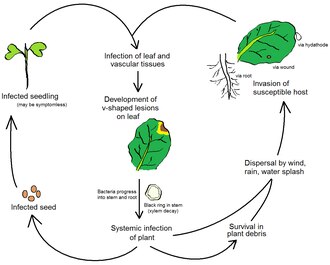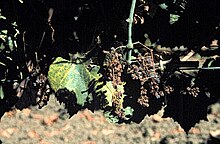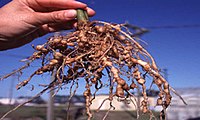Plant disease

Plant diseases are diseases in
Plant pathogens
Fungi

Most phytopathogenic fungi are
Fungal diseases may be controlled through the use of
that are resistant to various fungicides.Biotrophic fungal pathogens colonize living plant tissue and obtain nutrients from living host cells.
Significant fungal plant pathogens include:
Ascomycetes
- Fusarium spp. (Fusarium wilt disease)
- Thielaviopsis spp. (canker rot, black root rot, Thielaviopsis root rot)
- Verticillium spp.
- Magnaporthe grisea (rice blast)
- Sclerotinia sclerotiorum (cottony rot)
Basidiomycetes
- Ustilago spp. (smuts)[4]
- Rhizoctonia spp.[5]
- Phakospora pachyrhizi (soybean rust)[6]
- grasses)(fungus)|rusts]].[7]
- Armillaria spp. (honey fungus species, virulent pathogens of trees)[8]
Fungus-like organisms
Oomycetes
The
Despite not being closely related to the fungi, the oomycetes have developed similar infection strategies, using effector proteins to turn off a plant's defenses.[13]
Phytomyxea
Some
Bacteria

Most
Most plant pathogenic bacteria are bacilli. Erwinia uses cell wall–degrading enzymes to cause soft rot. Agrobacterium changes the level of auxins to cause tumours with phytohormones.
Significant bacterial plant pathogens include:
- Burkholderia[16]
- Pseudomonadota
- Xanthomonas spp.[17]
- Pseudomonas spp.
- Pseudomonas syringae pv. tomato causes tomato plants to produce less fruit, and it "continues to adapt to the tomato by minimizing its recognition by the tomato immune system."[18]
Mollicutes


Viruses
Many plant viruses cause only a loss of
Most plant viruses have small, single-stranded
Plant viruses are generally transmitted by a
Nematodes

Some
Protozoa
A few plant diseases are caused by
Physiological plant disorders
Some abiotic disorders can be confused with pathogen-induced disorders. Abiotic causes include natural processes such as drought, frost, snow and hail; flooding and poor drainage; nutrient deficiency; deposition of mineral salts such as sodium chloride and gypsum; windburn and breakage by storms; and wildfires. [24]

Epidemics
This section needs expansion. You can help by adding to it. (December 2023) |
Plants are subject to disease epidemics.
Port and border inspection and quarantine
The introduction of harmful nonnative organisms into a country van be reduced by controlling human traffic (e.g., the Australian Quarantine and Inspection Service). Global trade provides unprecedented opportunities for the introduction of plant pests.[McC 1] In the United States, even to get a better estimate of the number of such introductions would require a substantial increase in inspections.[McC 2] In Australia a similar shortcoming of understanding has a different origin: Port inspections are not very useful because inspectors know too little about taxonomy. There are often pests that the Australian Government has prioritised as harmful to be kept out of the country, but which have near taxonomic relatives that confuse the issue.[BH 1]
X-ray and electron-beam/E-beam irradiation of food has been trialed as a quarantine treatment for fruit commodities originating from Hawaii. The US FDA (Food and Drug Administration), USDA APHIS (Animal and Plant Health Inspection Service), producers, and consumers were all accepting of the results - more thorough pest eradication and lesser taste degradation than heat treatment.[25]
The
Chemical
Many natural and synthetic compounds can be employed to combat plant diseases. This method works by directly eliminating disease-causing organisms or curbing their spread; however, it has been shown to have too broad an effect, typically, to be good for the local ecosystem. From an economic standpoint, all but the simplest natural additives may disqualify a product from "organic" status, potentially reducing the value of the yield.
Biological
Crop rotation is a traditional and sometimes effective means of preventing pests and diseases from becoming well-established, alongside other benefits.[27]
Other biological methods include inoculation. Protection against infection by
Economic impact
Plant diseases cause major economic losses for farmers worldwide. Across large regions and many crop species, it is estimated that diseases typically reduce plant yields by 10% every year in more developed settings, but yield loss to diseases often exceeds 20% in less developed settings. The Food and Agriculture Organization estimates that pests and diseases are responsible for about 25% of crop loss. To solve this, new methods are needed to detect diseases and pests early, such as novel sensors that detect plant odours and spectroscopy and biophotonics that are able to diagnose plant health and metabolism.[29]
As of 2018[update] the most costly diseases of the most produced crops worldwide are:[30]
See also
- Burl
- Common names of plant diseases
- Plant disease forecasting
- Stunting
Notes
- ^ p. 17, "It is clear, however, that continuing increases in global trade and travel will provide opportunities for nonindigenous species to be transported into the U.S. at rates that are unprecedented in world history."
- ^ p. 17, " A more comprehensive estimate of the frequency and diversity of nonindigenous plants, particularly those introduced as contaminants in cargo, would likely require a substantial increase in inspection efforts by APHIS personnel."
- ^ p. 39, Table 2
References
- ^ Agrios GN (1972). Plant Pathology (3rd ed.). Academic Press.
- PMID 33173596.
- ^ Yu. T Dyakov, Chapter 0 - Overview on parasitism, Editors: Yu, T. Dyakov, V.G. Dzhavakhiya, T. Korpela, Studies in Plant Science, Comprehensive and Molecular Phytopathology, Elsevier, 2007, Pages 3-17, ISSN 0928-3420, ISBN 9780444521323, https://doi.org/10.1016/B978-044452132-3/50003-1.
- ^ Begerow, D.; Schäfer, A.M.; Kellner, R.; Yurkov, A.; Kemler, M.; Oberwinkler, F.; Bauer, R. (2014). "Ustilaginomycotina.". In McLaughlin, D.J.; Spatafora, J.W. (eds.). The Mycota. Vol. VII Part A. Systematics and Evolution (2 ed.). Berlin.: Springer-Verlag. pp. 295–329.
- ISBN 1-900347-69-5.
- National Invasive Species Information Center. 2012-02-24. Retrieved 2020-12-06.
- ^ "Fungi", Lillian E Hawker, 1966, p. 167
- ^ Daley, Jason (15 October 2018). "This Humongous Fungus Is as Massive as Three Blue Whales". Smithsonian.com. Smithsonian Institution. Retrieved 21 October 2018.
- ^ a b Davis N (September 9, 2009). "Genome of Irish potato famine pathogen decoded". Haas et al. Broad Institute of MIT and Harvard. Retrieved 24 July 2012.
- ISSN 0100-5405.
- PMID 25178392.
- PMID 19019002.
- ^ "Scientists discover how deadly fungal microbes enter host cells". (VBI) at Virginia Tech affiliates. Physorg. July 22, 2010. Retrieved July 31, 2012.
- PMID 29024322.
- ISBN 978-1-904455-37-0.
- PMID 18104350.
- PMID 31578554.
- ^ "Research team unravels tomato pathogen's tricks of the trade". Virginia Tech. 2011.
- S2CID 23419581.
- PMID 30795425.
- PMID 26450274.
- PMID 35187578.
- PMID 3253512.
- ^ Schutzki, R.E.; Cregg, B. (2007). "Abiotic plant disorders: Symptoms, signs and solutions. A diagnostic guide to problem solving" (PDF). Michigan State University Department of Horticulture. Michigan State University. Archived from the original (PDF) on 24 September 2015. Retrieved 10 April 2015.
- S2CID 93883640.
- ^ a b International Plant Protection Convention (IPPC) (2021). Strategic framework for the International Plant Protection Convention (IPPC) 2020–2030 : Protecting global plant resources and facilitating safe trade. Rome: UN FAO (Food and Agriculture Organization of the United Nations). pp. viii + 28.
- ^ Dufour, Rex (July 2015). Tipsheet: Crop Rotation in Organic Farming Systems (Report). National Center for Appropriate Technology. Retrieved 4 May 2016.
- .
- S2CID 18000844.
- PMID 29787730.
